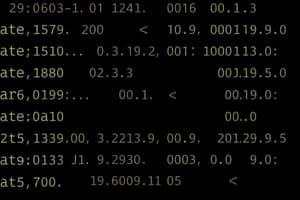Podcast
Questions and Answers
Describe the key difference between structured and unstructured data, and provide an example of each.
Describe the key difference between structured and unstructured data, and provide an example of each.
Structured data is organized in a predefined format, like a database table with labeled columns and rows. It is easily analyzed. Examples include spreadsheets and relational databases. Unstructured data lacks a defined format and is found in text documents, images, audio, and video. It often requires advanced techniques for analysis. Examples include emails, social media posts, and audio recordings.
Explain the distinction between quantitative and categorical data. Give a real-world example of each.
Explain the distinction between quantitative and categorical data. Give a real-world example of each.
Quantitative data represents numerical measurements, often expressed as numbers or figures. Examples include height, weight, or temperature. Categorical data represents categories or labels, often expressed as words or symbols. Examples include colors, gender, or types of animals.
What are the primary challenges associated with analyzing big data? How does the data science process address these challenges?
What are the primary challenges associated with analyzing big data? How does the data science process address these challenges?
Big data presents challenges due to its volume, velocity, variety, and veracity. The data science process addresses these through a structured approach. It involves defining research goals to clarify objectives. Retrieving data gathers information. Data preparation and exploration are crucial for cleaning, organizing, and identifying patterns or trends. Data modeling creates models to predict future results. Finally, presentation and automation help communicate findings and implement solutions.
Explain the importance of data visualization in the data science process, and provide at least one example of a visualization technique.
Explain the importance of data visualization in the data science process, and provide at least one example of a visualization technique.
Why are toolboxes crucial for data scientists? Discuss at least two specific types of tools that might be included in such a toolbox.
Why are toolboxes crucial for data scientists? Discuss at least two specific types of tools that might be included in such a toolbox.
Flashcards
Structured Data
Structured Data
Data organized in a defined format, such as tables.
Unstructured Data
Unstructured Data
Data that does not have a predefined format, such as text or images.
Quantitative Data
Quantitative Data
Numerical data that can be measured and categorized.
Data Visualization
Data Visualization
Signup and view all the flashcards
Data Science Process
Data Science Process
Signup and view all the flashcards
Study Notes
Data Types
- Structured Data: Organized in a predefined format, typically in tables or databases. Easy to query and analyze.
- Unstructured Data: Not organized in a predefined format, including text, images, and audio. More complex to analyze.
- Quantitative Data: Numerical data, representing quantities. Examples include height, weight, temperature.
- Categorical Data: Data that represents categories or groups, such as colors, types of fruit, or customer segments.
Data Sizes
- Big Data: Extremely large datasets too big for traditional data processing tools. Characteristics are volume, velocity, variety, veracity, and value.
- Little Data: Smaller datasets, often used for initial exploration or hypothesis testing.
Data Science Process
- Defining Research Goals: Clearly stating the purpose of the data analysis.
- Retrieving Data: Gathering the necessary data from various sources.
- Data Preparation: Cleaning, transforming, and preparing the data for analysis. This often includes handling missing values, outliers, and inconsistencies.
- Data Exploration: Initial analysis and visualization to understand the data (e.g., distributions, relationships).
- Data Modeling: Developing models (e.g., machine learning models) to extract insights.
- Presentation and Automation: Presenting findings in a clear and actionable format, including visualizations. Automation can streamline analysis and reporting efforts.
- Data Visualization: Using graphs, charts, and other visual aids to communicate data insights.
Tools for Data Scientists
- Data scientists utilize various tools depending on specific tasks.
Studying That Suits You
Use AI to generate personalized quizzes and flashcards to suit your learning preferences.




